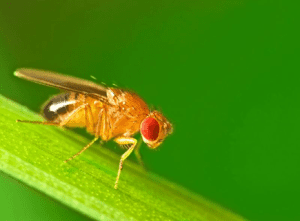TAG: GS 3: SCIENCE AND TECHNOLOGY
THE CONTEXT: Recently, in a study genetically engineered fruit flies were utilised to express mutated human HTT genes in their nervous systems.
EXPLANATION:
- HTT is a gene code for a protein called huntingtin.
- Leveraging the Gal4/UAS system from baker’s yeast, researchers induced the expression of abnormal Htt proteins with extended glutamine repeats (120 units) specifically in fruit fly neurons.
- These flies exhibited neuronal degeneration, impaired motor function, reduced viability, and lifespan.
Critical Discovery: The Yod1 Gene’s Impact
- Researchers tested 32 genes and identified Yod1’s significant impact when overexpressed in fruit flies.
- Elevated Yod1 expression reversed disease-like effects, restoring neuronal health, motor function, and viability.
- Notably, flies expressing shorter glutamine tracts or co-expressing Yod1 showed no signs of neurodegeneration.

Potential Implications and Future Research
- The study’s findings highlight Yod1’s potential therapeutic role in Huntington’s disease, indicating a possible avenue for intervention.
- However, further research is crucial to validate these results in humans.
- Fruit fly studies provide invaluable insights into the molecular mechanisms underlying disease progression, offering unparalleled flexibility compared to clinical or postmortem investigations.
Understanding Huntington’s Disease: Molecular Level Insights
- Huntington’s disease is a devastating neurodegenerative disorder characterized by a mutated HTT gene, leading to the production of an abnormal protein called huntingtin (Htt).
- This defective protein triggers the destruction of neurons controlling movement, cognition, and memory.
- Patients initially experience mild symptoms like forgetfulness and clumsiness, progressing to severe motor and cognitive impairments.
Molecular Basis: Glutamine Repeats and Dominant Gene Mutation
- The normal HTT gene contains a specific sequence encoding glutamine repeats (11 to 31 times).
- In the mutated HTT gene, this sequence expands to 35 or more repeats, correlating with increased disease severity and earlier onset.
- Huntington’s disease is triggered even if only one copy of the gene is mutated, displaying dominance over the normal gene.
Role of Polyglutamine Tracts and Neuronal Degeneration
- Several proteins, like Htt, possess polyglutamine tracts encoded by larger DNA sequences in mutated genes.
- These expanded tracts can cause region-specific neuronal degeneration in the brain, disrupting cellular processes and leading to various motor control disorders.
Toxic Fragments and Neuronal Sensitivity
- Enzymes cutting proteins with polyglutamine tracts produce toxic fragments interfering with cellular functions.
- Different neurons exhibit varied sensitivity to these fragments, affecting neuronal health differently across regions.
Conclusion: Collaborative Efforts in Disease Research
- As the study indicates the potential benefits of Yod1 in mitigating Huntington’s-like symptoms in fruit flies, it raises optimism for similar effects in humans.
- The use of model organisms, like yeast and fruit flies, showcases the collaborative effort involving various scientific communities dedicated to unravelling complex diseases like Huntington’s.
- These findings underscore the significance of multidisciplinary approaches in advancing medical understanding and potential treatments.
SOURCE: https://www.thehindu.com/todays-paper/2023-12-28/th_chennai/articleGUJC6U026-5321280.ece
Spread the Word
